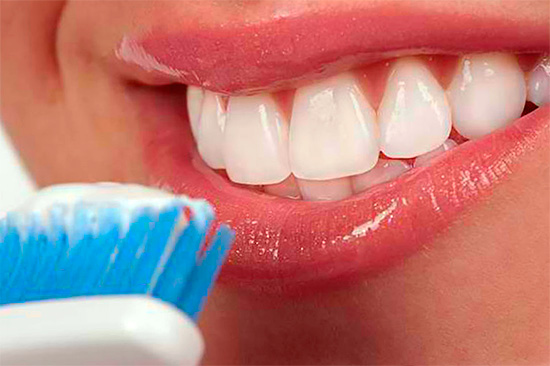
Next you will learn:
- How is mechanical lightening of teeth different from chemical whitening;
- What are the operating principles of different whitening toothpastes, and what advertising is silent about;
- What is important to know about the whitening components of toothpastes indicated in the composition;
- Why is it important to consider the RDA controlled abrasivity index when choosing a paste;
- What specific whitening toothpastes are better, and which of them each have features and “highlights”;
- You will also learn about important practical rules for choosing and using whitening pastes, which will make it possible not to harm your teeth too much if something happens.
The high popularity of whitening toothpastes, due largely to massive advertising today, often leads to the fact that they are bought by almost every second resident of our country. Moreover, in the pursuit of a snow-white smile, not everyone takes into account the potential danger of whitening paste, especially in the case of an incorrect choice.
First of all, it should be borne in mind that not all whitening toothpastes are equally effective and safe to use. The principle of operation of most of them is based on the abrasive abrasion of colored plaque - while the enamel itself is almost always to some extent abrased. In turn, this can lead to various problems with the teeth, of which the most obvious is their increased sensitivity to the action of various irritants (for example, cold or solid food).
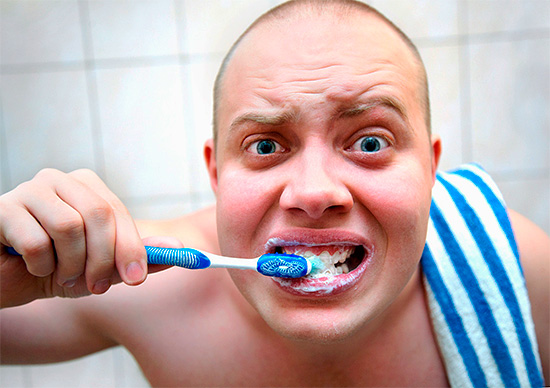
This state of affairs is also confirmed by the reviews of many people who are trying to return their snow-white to their smile: together with the charming white color of the teeth, their high sensitivity very often arises.
Feedback:
“So I don’t know how others manage to choose whitening paste for themselves, but I already tried 8 pieces from different companies. I tried both praised Japanese pastas, both German and Italian Presidents, but with my sensitive teeth, they are all too rough, or something. They bleach bleach, but at the same time it starts to break teeth directly. Moreover, I tried some pastes, such as those designed specifically for sensitive teeth, and after 2-3 cleanings from them it’s not like apples - bread is impossible ... ”
Vadim, St. Petersburg
In addition, sometimes characteristic depressions appear in the cervical region - wedge-shaped defects (at first they can be almost invisible, but if a person frantically rubs enamel with improperly selected whitening paste for several months, then these “grooves” gradually become very deep).
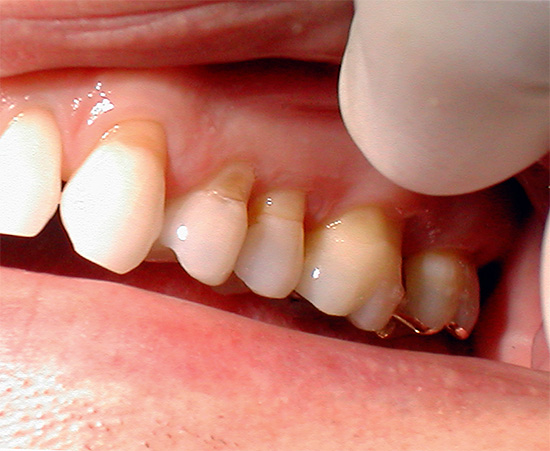
Meanwhile, by choosing the right whitening toothpaste, in many cases it is really possible to visibly lighten your smile with minimal risks to dental health. So which toothpaste whitens teeth best and is safe to use? How to choose the best option for yourself and what you should pay attention to - let's talk about this in more detail.
And to make the choice more meaningful, it is useful to first say a few words about interesting nuances regarding the principle of action of whitening pastes ...
Principles of action of whitening pastes
It is important to distinguish between the concepts of “lightening” and “whitening” of teeth.
Tooth brightening refers to the removal of colored plaque from the enamel surface, which is formed after eating, drinking a cup of coffee or smoking a cigarette. A good whitening toothpaste effectively removes plaque, and the smile acquires a natural enamel color. The key point here is that enamel should be naturally light enough.
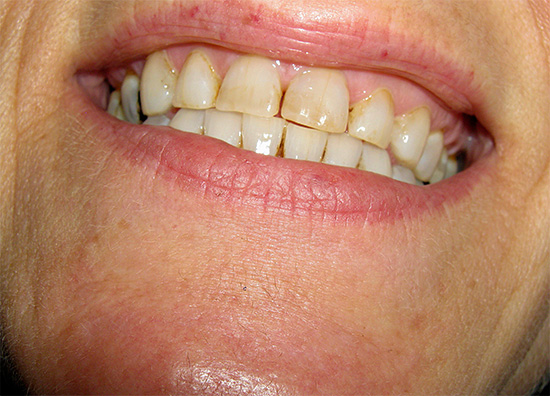
On a note
In some people, tooth enamel is naturally yellow.Accordingly, even the best whitening toothpaste will not be able to lighten the teeth in this case.
A separate story is when enamel is naturally light, but over time it has become dark due to the penetration of coloring substances into it to a certain depth from the outside. In this case, getting a snow-white smile with the help of whitening pastes also does not work, since you need to not just lighten, but bleach such an enamel.
Teeth whitening (as opposed to lightening) involves the chemical discoloration of colored compounds located not only on the enamel surface, but also in its surface layer to a certain depth. For example, such whitening can be carried out from the dentist's office - for this, a special gel is used that contains rather high concentrations of acid and hydrogen peroxide (photo-whitening of teeth is especially popular today).
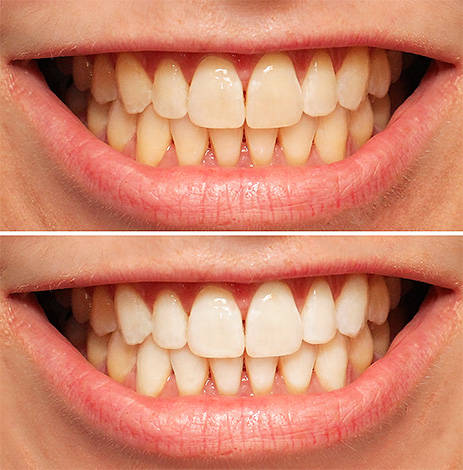
Some manufacturers of whitening toothpastes, in pursuit of the consumer, indicate that their product whitens due to the action of “active oxygen”: in the composition of the paste, you can see the presence of hydrogen peroxide (usually 1-2%, or even less). So, many dentists consider this technique in many ways a publicity stunt, since the severity of the whitening effect of hydrogen peroxide in such a low concentration is very doubtful. It is impossible to use a higher concentration, since it will already be unsafe for the oral mucosa.
And again, if tooth enamel is naturally dark (yellow), then neither room whitening, nor, all the more, whitening toothpastes will give a significant effect.
It is interesting
Just imagine such a thing: in some clinics they immediately honestly say that even after several treatments with aggressive acids in combination with hydrogen peroxide even at a 30% concentration for 20-30 minutes, the whitening effect may not be achieved, even if you crack, one semitone on a scale.
And one more thing: for a number of people the procedure of “real” (cabinet) whitening brings a rather weak result (half tone). This suggests that it is practically impossible to etch naturally enamelled teeth from enamel layers.
A whitening toothpaste gives a good effect if the enamel is naturally light, but there is a colored coating on its surface.
Removal of plaque during brushing can occur in two significantly different ways:
- Due to simple abrasive erasure. This is similar to cleaning the pan with a special brush: toothpaste for whitening teeth “scratches” plaque due to abrasive components, gradually cleansing it. The advantage of this method lies in its high efficiency - with high abrasiveness of the paste, you can lighten your teeth in literally a few days. The main drawback of the method is damage to the enamel itself by abrasive particles (simply put, the enamel is erased too). Highly abrasive toothpastes in this regard are most dangerous, especially with prolonged and improper use, therefore it is recommended to use them only in short courses. The photo below shows how you can polish, for example, the glass of a car headlight with whitening paste:



- The second way to remove plaque is to dissolve it with special enzymes (for example, papain, bromelain). Such enzymes do not erase plaque, but chemical ones break down its protein base - food debris, bacterial membranes and their waste products. Thus, plaque can be removed very gently, without excessive abrasion on the enamel, which is especially important for sensitive teeth.
As a rule, the presence of enzymes in the composition of the paste leads to a noticeable increase in its cost. In addition, the presence of enzymes does not preclude the simultaneous use of a gentle abrasive polishing system with a low RDA abrasive index in the composition of the paste, which we will talk about below.
On a note
Toothpastes may also contain components that help remove tartar.In part, it is removed by the abrasive-polishing system, however, the presence of polyphosphates in the paste (for example, sodium or potassium pyrophosphate, sodium tripolyphosphate, etc.) significantly accelerates this process.
Polyphosphates, being effective complexing agents, “pull” calcium from the tartar matrix, loosening its structure and making it more malleable to mechanical scraping. At the same time, it is important to keep in mind that at the same time calcium will be partially washed out of tooth enamel, so polyphosphates are usually not added to toothpastes intended for sensitive teeth.
As noted above, the removal of pigments from the deep layers of enamel using whitening toothpastes is practically impossible to achieve, even if a small amount of peroxide compounds is present in the composition. Although in some reviews, optimists suggest that they look like whitened toothpaste with hydrogen peroxide on the teeth for 30 minutes 2-3 times a day - and a supposedly certain whitening effect is nevertheless achieved (how the mucous membrane behaves from such "bullying" is kept silent) .
On a note
Sometimes they try to use activated charcoal to whiten their teeth, believing that due to the high adsorption ability, he will pull pigments from the enamel and thereby bleach it. In reality, cleaning with charcoal, including activated charcoal, is not able to get rid of deep enamel staining, but can only remove colored plaque from its surface.
Charcoal Toothpaste Example - Blackwood Splat.
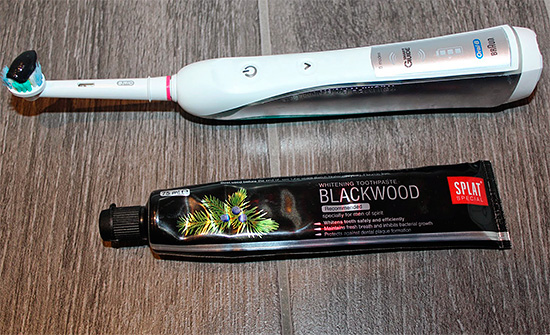
Whitening components of pastes
The key components of whitening pastes that are responsible for the target effect can be divided into four groups:
- Abrasive polishing components;
- Plaque-dissolving enzymes;
- Bleaching peroxide compounds;
- As well as complexing agents that contribute to the removal of plaque and tartar.
Of the abrasive components in whitening pastes, the following are most often used:
- Silicon compounds (Silica - silicon dioxide, Hydrated Silica - silicic acid; silicates, for example, aluminosilicates, are less commonly used). Amorphous silicon dioxide and silicic acid allow you to quite accurately remove plaque, without greatly damaging the enamel. Since these compounds are obtained synthetically, the degree of their abrasiveness can be set at the factory. The advantage of these silicon compounds is their chemical inertness - they do not react with other components of toothpaste, and also usually do not cause allergic reactions.
- Calcium carbonate (Calcium Carbonate), very popular earlier due to its low cost, but today it is used much less and mainly only in pastes with high abrasiveness. Due to the special form of crystalline particles, calcium carbonate is very abrasive, it provides a quick whitening effect in the paste, but also severe damage to the enamel.
- Titanium Dioxide, a fairly mild abrasive when used in low concentration. In addition, this substance can be found in almost any white toothpaste, as "in combination" titanium dioxide is a highly effective white pigment (used in white paints).
It is interesting
Perhaps, among the abrasive components of toothpastes, polyethylene (Polyethylene) is also worth mentioning.
In relation to this abrasive, not everything is so simple - the use of the smallest dispersions of plastic particles has been used for a relatively long time in the production of toothpastes of some popular brands. However, there are studies that indicate the harm of such particles of polyethylene. According to these studies, the smallest plastic particles get stuck in the gum pockets, between the teeth, and, being biodegradable, stay here for a long time, while promoting the attraction of bacterial microflora to their surface. As a result, this creates the risks of developing periodontitis.
In particular, the manufacturer Crest Toothpastes decided to exclude polyethylene from their composition.
More examples of abrasive components: clay (used in thai toothpastes), charcoal (as mentioned above in Splat Blackwood), baking soda (sodium bicarbonate, for example, in Parodontax pastes), etc.
The degree of abrasiveness of the whitening toothpaste depends not only on what chemical compounds are used as abrasives in it, but also on their preparation or production method (which, in turn, determines the particle size of the substance and their shape). Therefore, even looking at the composition of the paste, it is not always possible to clearly say how abrasive it will be.
Now a few words about the enzymes used in toothpastes:
- Papain is a natural enzyme of the Carica papaya melon tree. By its property, papain is much like gastric juice, since it effectively breaks down proteins. By acting on the protein base of plaque, papain contributes to its destruction and easy removal with a toothbrush.

- Bromelain (Bromelain), obtained from pineapple juice. Just like papain, it helps break down plaque proteins.

Among the bleaching peroxide compounds in the composition of toothpastes you can find the following substances:
- Hydrogen peroxide;
- Urea peroxide (a derivative of urea and hydrogen peroxide).
The concentrations of these substances in the composition of toothpastes are so small that the whitening effect of peroxides is practically zero. However, the advertising effect is very good - the promise of teeth whitening with active oxygen really encourages people to opt for such pastes. Meanwhile, the pastes themselves can be good, brightening the enamel due to abrasive components and (or enzymes).
The following compounds contribute to the removal of tartar (and with it plaque):
- Potassium or sodium pyrophosphate (Tetrapotassium Pyrophosphate, Tetrasodium Pyrophosphate);
- Sodium hexametaphosphate;
- Sodium tripolyphosphate;
... and other polyphosphates. It should be borne in mind that due to their ability to bind calcium ions, these compounds can contribute to enamel demineralization and the development of tooth sensitivity.
Given these subtleties, as well as focusing on the feedback of dentists and people who have tried different means, you can make a small rating of whitening toothpastes - we will consider it later. But before that, let's briefly touch on such an important issue as the quantitative assessment of the abrasiveness of toothpastes, expressed by the RDA index.
RDA Toothpaste Controlled Abrasiveness Index
The abrasiveness of most toothpastes today is controlled and quantified by the RDA index (with the exception of exotic toothpastes, for example, from Thailand, whose properties, it seems, almost no one controls at all).
Depending on the index of controlled abrasiveness, RDA pastes can be divided into the following types:
- For sensitive teeth: 25 RDA;
- Children's toothpastes: usually from 25 to 50 RDA;
- For daily use: 70-80 RDA (usually indicate 75). With an abrasive level above 80 RDA, the paste is no longer recommended for daily use, as enamel can be excessively abrased with prolonged use;
- Relatively speaking, relatively soft whitening pastes: 100-150 RDA. Used in most cases for teeth whitening with normal sensitivity;
- Highly abrasive whitening pastes: RDA above 150 (sometimes good for smokers with healthy and strong, but yellow teeth).
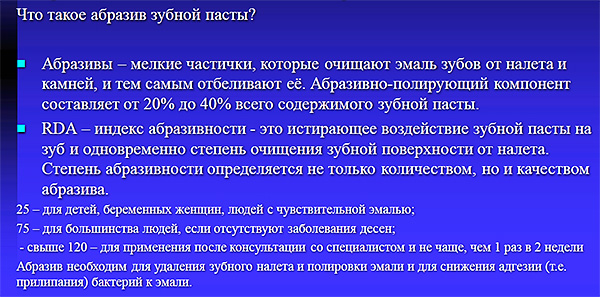
High Whitening Toothpaste Rating
Pastes of this group will help brighten the smile for people with naturally light tooth enamel, which has darkened, for example, due to smoking, hobby for coffee or tea. An important point in this case - the teeth should not be prone to sensitivity: if the enamel is initially weak, painfully reacts to cold or solid food, then the use of the following whitening pastes will significantly aggravate such sensitivity.
PresiDENT White Plus:
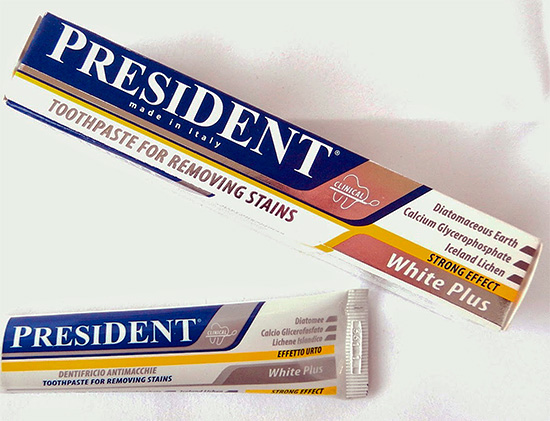
- Production - Italy;
- RDA - 200;
- Abrasive components: silicon dioxide, calcium carbonate, diatomite, titanium dioxide;
- Additional active components: calcium glycerophosphate (promotes enamel remineralization);
- Fluorine content: does not contain F;
- The price is about 300 rubles per tube per 100 ml.
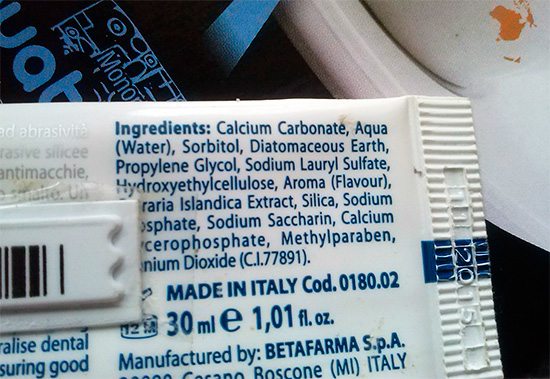
This is the “toughest” of the pastes presented in this review. It’s not a bad idea to whiten (more precisely, brightens) teeth, and many reviews indicate that the effect is observed literally after 2-3 applications. According to the instructions, you can not use it more than once a week due to the strong abrasion of enamel.
Additional comments
Adolescents and people with pathological abrasion of tooth enamel and its high sensitivity from this toothpaste should stay away.
It is also worth noting the presence of sodium lauryl sulfate in the paste, around which a very negative information background has formed today - this substance is attributed not only to the ability in some cases to cause ulcers in the mouth (not unreasonably), but even carcinogenic properties (very doubtful).
The preservative, in which methylparaben was used, was also included in the composition. This substance can cause a severe allergic reaction.
R.O.C.S. Sensational Whitening:
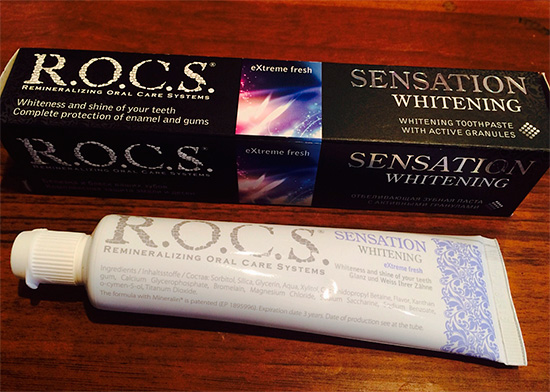
- Production - Russia;
- RDA - 139;
- Abrasive components: silicon dioxide, titanium dioxide;
- Additional active ingredients: bromelain (breaks down plaque), calcium glycerophosphate (serves to remineralize enamel);
- Fluorine content: does not contain F;
- The price is about 250 rubles per tube for 74 g.
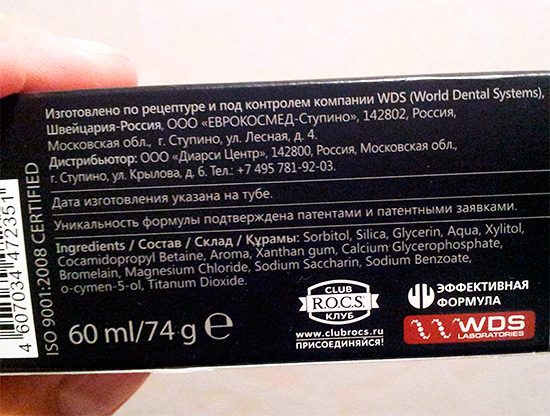
On the whole, the composition of this whitening toothpaste can be called quite “advanced”: in addition to abrasive effects, it will dissolve colored plaque due to the enzyme bromelain. In addition, enamel damaged by abrasive particles will be restored to a certain extent due to the mineralization of calcium glycerophosphate - this is a significant plus, since the risk of developing enamel sensitivity is reduced.
A pleasant moment is the absence of R.O.C.S. in the paste. Sensational Whitening of sodium lauryl sulfate, parabens, as well as powerful and not always useful antibacterial components (chlorhexidine, triclosan).
Feedback
“I bought Rox Sensational whitening on the advice of a friend. Before that, I used Bionika for a long time, but I want to whiten my teeth well, so I decided to take something new and more powerful. I cleaned it as usual, twice a day. A friend said that this is the best toothpaste, but I still don’t agree. It bleaches, but I would not say that it is very far, far from perfect whiteness. And I want even whiter, I’ll have to look for something further ... "
Olya, Novokuznetsk
Lacalut White:
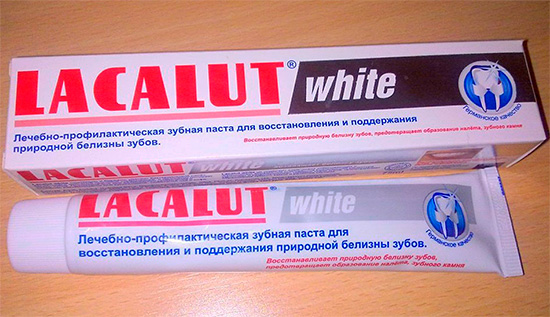
- Production - Germany;
- RDA - about 120;
- Abrasive components: silicon dioxide, silicic acid, titanium dioxide;
- Additional active ingredients: sodium pyrophosphate, potassium pyrophosphate, sodium triphosphate (all three compounds contribute to the destruction of tartar and plaque removal), sodium fluoride (helps enamel mineralization), aluminum lactate (strengthens the gums and prevents their inflammation);
- Fluorine Content: 1357 ppm;
- The price is about 300 rubles per 75 ml tube.
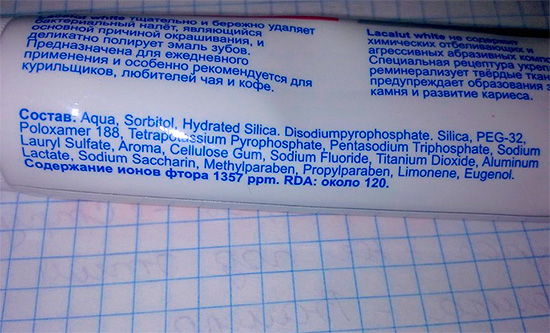
Pretty good composition, provided that your teeth are really strong. It should be borne in mind that the presence of potassium salts in the paste (potassium pyrophosphate - Tetrapotassium Pyrophosphate) will reduce the sensitivity of the enamel even in case of local damage, thereby masking alarming signs of excessive abrasion.
In general, the presence of sodium and potassium pyrophosphates, as well as sodium triphosphate, will favorably affect the removal of tartar. The capture of calcium by these polyphosphates from tooth enamel will be partially compensated by fluoride ions, which, on the contrary, will strengthen the structure of enamel, contributing to its mineralization. So the composition of this whitening toothpaste can be considered quite thoughtful and more or less balanced.
But the price, perhaps, is too high for such a composition, especially if you take into account the presence in it of the same sodium lauryl sulfate, as well as potentially allergenic preservatives (methyl paraben and propyl paraben).
Blendamed 3D White Luxe Glamor:
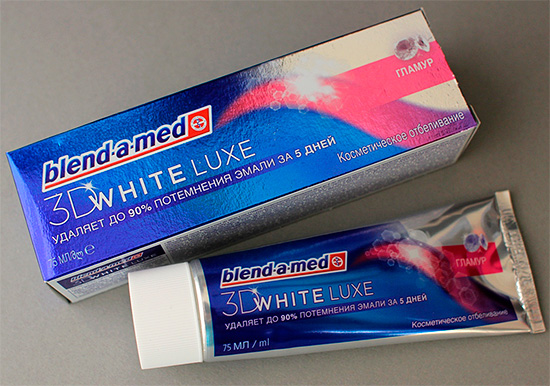
- Production: Germany;
- RDA - about 100;
- Abrasive components: silicic acid;
- Additional active components: sodium fluoride (contributes to the enamel mineralization), sodium pyrophosphate (favors the removal of tartar);
- Fluorine Content: 1450 ppm;
- The price is about 400 rubles per tube of 75 ml.
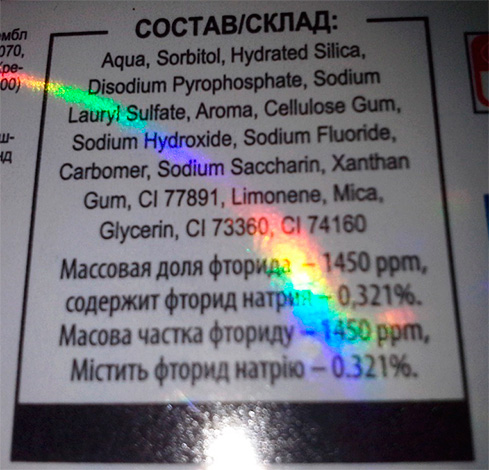
With a not very remarkable composition, one might even say rather poor, the price of this whitening toothpaste is clearly overpriced. Among the poles are, perhaps, the absence in the composition of parabens and sodium lauryl sulfate, which was replaced by a less aggressive surfactant, sodium laureth-2 phosphate.
Feedback:
“For a long time I was looking for which toothpaste whitens teeth better, I even bought Brilliant once. I literally killed her teeth, then I couldn’t eat anything but oatmeal, I was recovering for three months until the pains passed. Then I tried Blendamed 3D White Suite. This, of course, is the thing. I can’t say that this is right the coolest whitening paste, but even with it, my teeth don’t hurt. She’s price, of course, is not the smallest, but it’s in every way better than being tormented later. ”
Eugene, Moscow
Next, let's talk about whitening toothpastes containing peroxides (hydrogen peroxide or carbamide peroxide). Are they really good?
Peroxide Pastes
For these pastes, manufacturers declare not only whitening (lightening) due to the removal of stained plaque from the surface of the teeth, but also due to the chemical discoloration of stained compounds in the structure of tooth enamel. This bleaching effect is attributed to active oxygen, which is capable of being released from peroxides.
ROCS PRO Oxygen whitening (positioned as a professional whitening gel toothpaste):
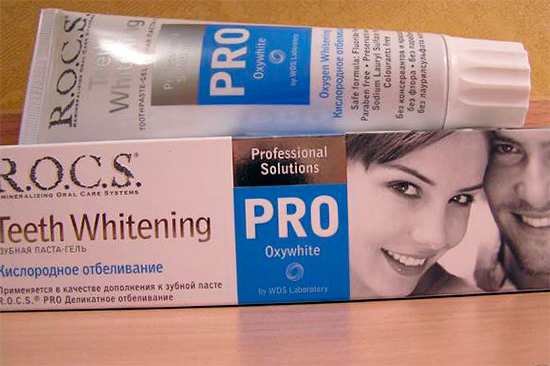
- Production - Russia;
- RDA - no data, the manufacturer indicates "a very low abrasion index", and also warns that the paste does not have polishing properties and is not able to effectively remove dental deposits;
- Abrasive components: polyethylene (generally speaking, polyethylene can hardly be called a typical abrasive component, and ROCS PRO Oxygen whitening is more of a gel than a paste);
- Additional active ingredients: carbamide peroxide (the main whitening ingredient), calcium glycerophosphate (for mineralization of enamel);
- Fluorine content: does not contain F;
- Price - 400 rubles per tube weighing 60 grams.
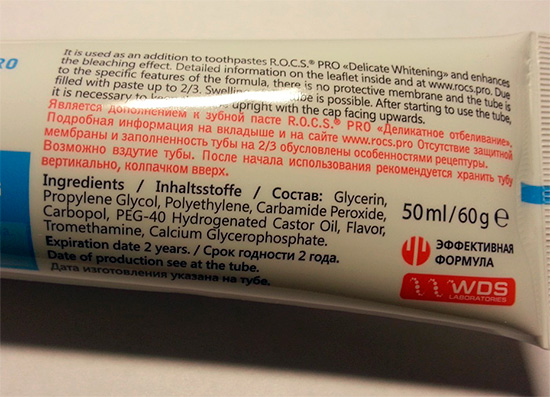
The bleaching course recommended by the manufacturer is 4 weeks, and the effect of bleaching is indicated on average by 2-3 tones (however, reviews do not always confirm this).
What you need to consider before buying this toothpaste:
- If you have a smoker's plaque or tartar on your teeth, then ROCS PRO Oxygen whitening will not be the best option, as it simply will not be able to remove deposits from the enamel surface. To whiten plaque and deposits, and not the enamel itself, is, as they say, money down the drain.
- As for the possibility of bleaching enamel with low concentration carbamide peroxide, this is a very dubious exercise that can be described in advance as having low efficiency. In the case, if the tooth enamel is dark (yellow) by nature, then it is not necessary to count on whitening.
Reviews:
“... Once I already took this paste, but somehow I didn’t understand it - it’s somehow strange. Recently decided to give her a second chance. Used only in the evenings, and in the morning Rox applied delicate whitening. Well what can I say, it was enough for me for a short while. Teeth became terribly sick when brushing. They hurt all the time while you clean. And they became sensitive, but somehow I didn’t particularly notice the whitening effect. ”
Dasha, St. Petersburg
“For several months I’ve been chewing this paste, but I’m not stopping, because there is an effect! The teeth just became a little whiter, especially the spaces between them, which I used to be yellowish. But her aggressiveness is not frail, sometimes I feel that the jaw is already aching with cold water. ”
Catherine, Perm
Splat Extreme White:
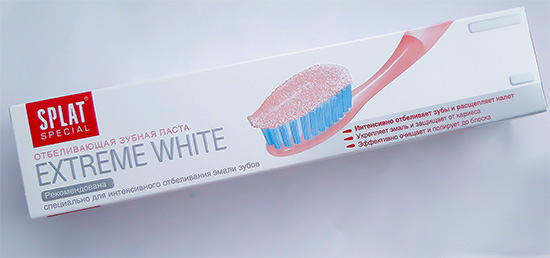
- Production - Russia;
- RDA - 75;
- Abrasive components: silicic acid;
- Additional active ingredients: carbamide peroxide granules (the main whitening ingredient), sodium fluoride (for mineralization of enamel), papain (for dissolving the protein base of plaque);
- Fluoride Content: 500 ppm;
- The price is about 250 rubles for 75 grams.
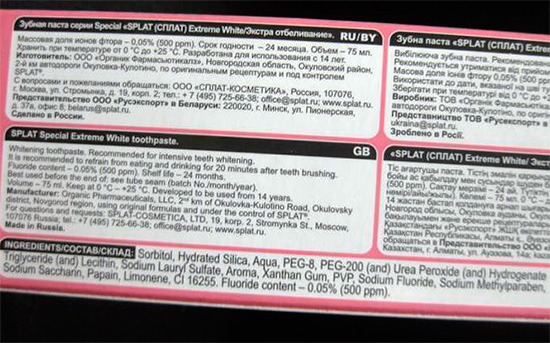
Unlike ROCS PRO Oxygen whitening, Splat Extreme White paste is characterized by a more complex effect on the teeth: there is an abrasive effect, and plaque dissolution due to papain enzyme, and, in fact, carbamide peroxide exposure to chemically discolor stained compounds in the surface layer of tooth enamel . With all this, the composition of the product also provides for some enamel mineralization due to sodium fluoride.
Among the shortcomings of the paste, the presence of sodium lauryl sulfate and the preservative methylparaben in its composition can be noted.
Faberlic White Plus:
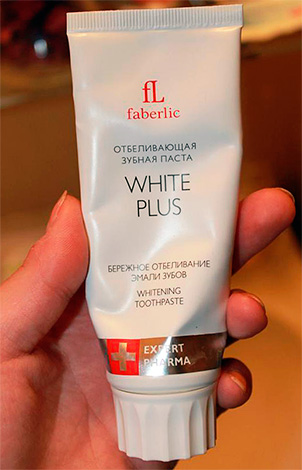
- Production - Russia;
- RDA - no data;
- Abrasive components: silicic acid;
- Additional active components: a complex of hydrogen peroxide with polyvinylpyrrolidone (the main whitening component), papain (for dissolving plaque);
- Fluorine content: does not contain active fluorine;
- The price is about 200 rubles for 75 grams.
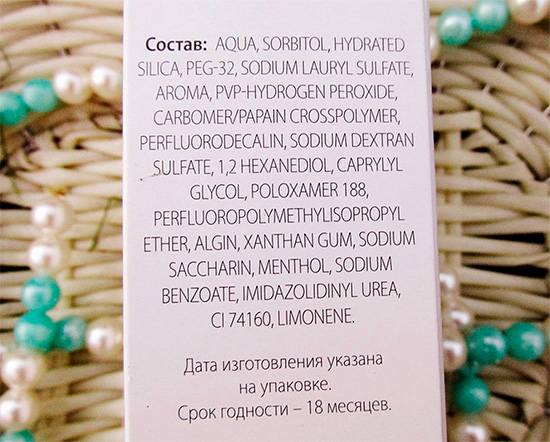
This paste is included in the review only because Faberlic distributors almost everywhere trumpet its amazing effectiveness. In fact, this paste does not contain anything extraordinary, which could provide a particularly high efficiency in tooth whitening.
Feedback
“Faberlik whitened my toothpaste with a distributor friend. In dentistry, I was always afraid to bleach, as they told me that it was harmful to enamel and all that jazz. So I realized that all my hopes for white teeth are contained somewhere in tubes with whitening pastes, you just need to find a good one. But the paste from Faberlic did not impress me. It seems to be inexpensive, tastes good, but I did not notice the whitening effect. They promised the golden mountains, but it turned out that she didn’t whiten very well. I don’t know how others have, but my gums started to hurt from her. Advise any other good whitening toothpaste. ”
Olga, Moscow
To the question of whether all teeth can be whitened ...
It is important to understand that if a person’s natural shade of tooth enamel is far from bright, then one should not expect a miracle even from the most expensive and effective whitening paste. With dark enamel, even after teeth whitening in the clinic, the result will be the most minimal.
On a note
Smokers, lovers of coffee, red wine, strong tea and chocolate should take into account the fact that when using whitening pastes, enamel becomes especially vulnerable to the penetration of colored compounds. Therefore, manufacturers often do not recommend taking coloring food for several hours after brushing their teeth with highly abrasive paste.
If, looking in the mirror, you see that there really is a lot of tartar on the teeth, then it is advisable to consult a dentist for a professional oral hygiene procedure (ultrasonic cleaning of teeth, Air-Flow). And only then use whitening pastes to prevent the re-formation of dental plaque. Otherwise, especially when choosing a low abrasive paste, getting a normal brightening effect can be very problematic.
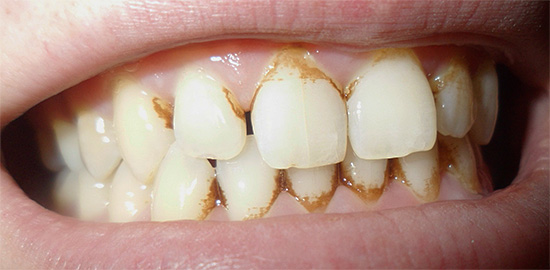
With weak enamel and increased tooth sensitivity, whitening pastes should be used very carefully, as this can significantly aggravate the problem. For example, the teeth will begin to hurt even more, and in the cervical zone, the so-called wedge-shaped defects may begin to deepen.
If you have fillings on your front teeth, it is useful to keep in mind that deep whitening of enamel, for example, hydrogen peroxide, would make these fillings look like dark patches in the smile zone. So in this case, the low efficiency of pastes with peroxides will be even better.
Rules for the selection and use of whitening pastes
Generally speaking, ideally, a whitening toothpaste should be applied under the supervision of a dentist - taking into account the individual characteristics of the patient's oral cavity and the dynamics of the paste itself. However, the situation is such that a significant part of people will not only not consult with the dentist on this matter, but generally do not even plan to visit him in the next couple of years.
Therefore, it makes sense in the end to give a number of practical tips on how to choose a whitening paste for yourself independently and without the help of a specialist, and how to apply it so that in case of something you do not harm your teeth too much.

So, these simple and effective recommendations:
- If the enamel is naturally dark, then you should not expect a miracle from the whitening paste - in most cases the effect will be minimal;
- If the teeth ache even from cold air or there is an unpleasant sensation from solid food, then when using a whitening paste the painful sensations will most likely become much stronger;
- If your teeth are already white enough, but no matter what, you want a "Hollywood" smile, then it makes sense to undergo a photo-bleaching procedure in the clinic;
- If after applying the whitening paste the teeth started to hurt, then do not torment them further - be sure to take a break of several weeks;
- If the teeth are full of tartar, then it makes sense to remove it in the dentist’s office, as it may not work out to completely remove it with bleaching paste;
- Highly abrasive whitening pastes should be used rarely, without confusing them with daily preparations (and if you mix them up, problems will not take long);
- When using whitening pastes, enamel mineralization should be taken care of in advance - look for products with calcium glycerophosphate, calcium citrate, sodium fluoride or aminofluoride (“active calcium”, “fluorine” can also be written).
- When choosing, pay attention to the composition of the whitening paste, and this article will help to draw the appropriate conclusions;
- Well, and finally - do not give whitening paste to children. Often the same paste is used in families at all, but you don’t want your child to wash his milk teeth with a paste with RDA 200? ..
If you have personal experience with whitening toothpastes, be sure to leave your review at the bottom of this page. Perhaps he will help someone make the right choice.
Interesting video on the safe use of whitening toothpastes
Comparison of the effectiveness of whitening paste and folk remedies for whitening tooth enamel

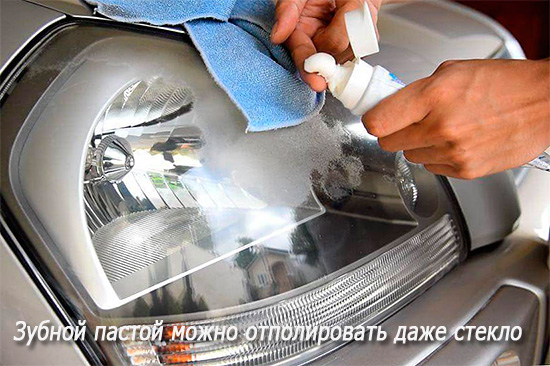
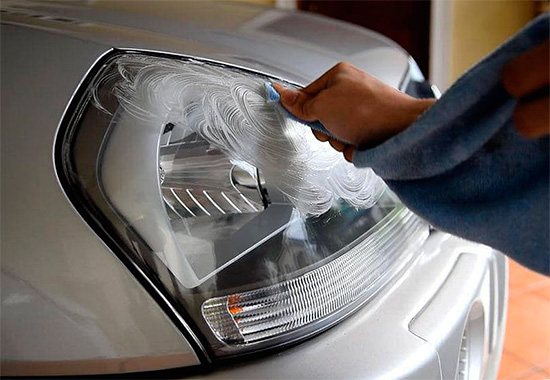
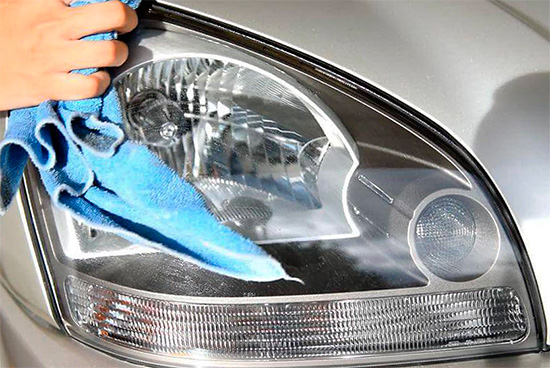
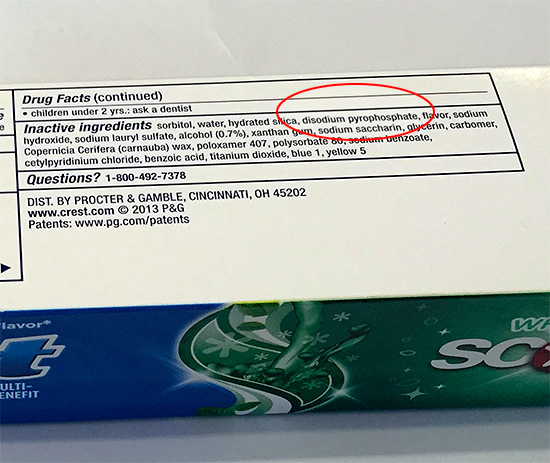
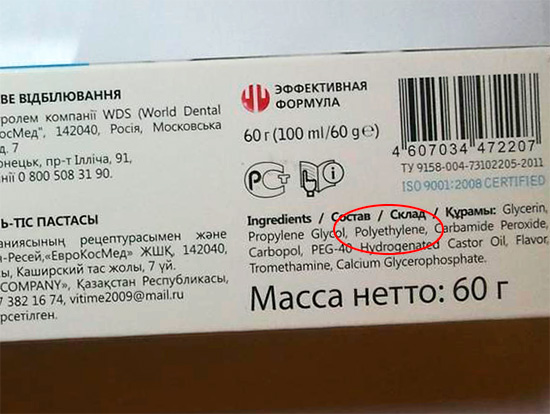
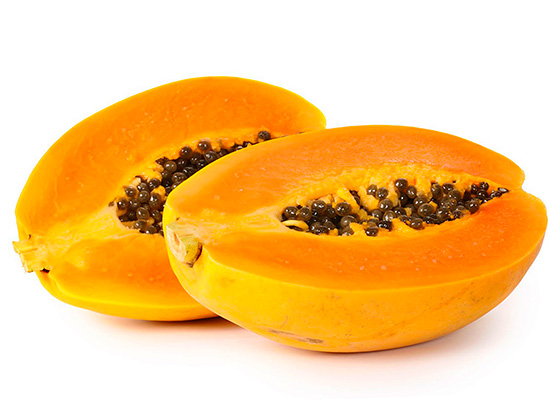

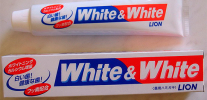
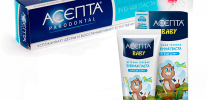
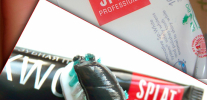
Thanks so much for the article. I learned a lot of information. After reading the article, I can recommend the Natura Siberica Pearl of Siberia paste - its composition is not bad, but I don’t know the abrasiveness.
Thank you so much for a very useful article. Nice to read, as there is no pronounced advertising of any product. I learned a lot of new things. I use toothpastes from Ireland from the Beverly Hills Formula brand. Started with a blue paste with microbeads, a very good effect, absolutely smooth enamel, teeth brilliance and a snow-white smile, especially under halogen lamps. Now I use toothpaste for sensitive teeth with activated carbon, hydroxyapatite - the same brand. I am delighted! Based on the soft mineral water of Ireland. In general, in Britain and Ireland, a boom in pasta containing coal. Try Beverly Hills Formula toothpastes and write your comments.